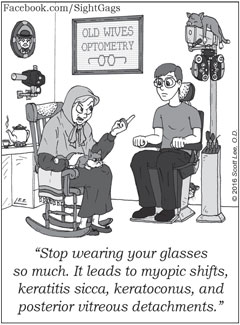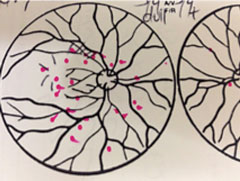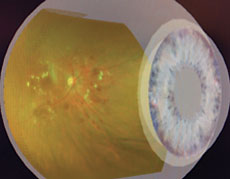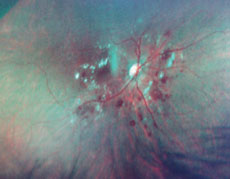High Praise
I read the 125th anniversary issue (July 2016) on planes to and from Nova Scotia. I think your staff did a superb job in the coverage. They really did.
The profession of optometry has made miraculous strides in the 70 or so years since I started practicing. The changes in goals and in scope of practice, in my opinion, have been greater than any other healthcare profession. I do hope that the younger generation does not forget the early years.
I have been a friend of Frank Fontana for years and years, and both Drs. Gurwood (the father and the son) are on my list of colleagues. It was a pleasure to see them featured in the issue.
Thank you for taking the time, and making the effort, to construct the theme of this issue. Congratulations to you and your colleagues for a job well done.
 |
| Click image to enlarge. |
—Irving Bennett, OD, Sarasota, FL
Out With the New, In With the Old
“Speaking Frankly: A Conversation with Frank D. Fontana, OD” (July 2016) was priceless! For us “old geezers,” who’ve been practicing for more than 50 years, hearing Dr. Fontana relate to the old days is something we greatly appreciate.
—Stan Pugh, OD, Tacoma, WA
Son of A. Fitch
Congratulations on 125 years of your eminent magazine. While reading about optometry’s evolution, I saw many prominent optometric names mentioned, including that of Albert Fitch. I attended the Pennsylvania State College of Optometry (1958-1962). This unique institution required a total of six years of education (about a third of the class had BA/BS degrees). All the other institutions required five years. PSCO included full courses in organic chemistry, biochemistry, neuroanatomy, human anatomy (dissected cadaver), mammalian anatomy (dissected cat), general pathology, ocular histopathology, ocular pathology and public health. In addition, all courses were appropriately instructed by individuals with PhD and MD degrees. Think of it! Sixty years later and today’s colleges have curricula patterned from PSCO’s model. That is why, in my humble opinion, Dr. Fitch’s name, for his many important contributions, should be more prominently recognized.
—Nathan Solat, OD, Staten Island, NY, PSCO 1962
Physician, Eat Thy Vitamins
I read with great interest the nutrition and roundtable discussion in the February issue (“Transforming Eye Health Through Proven Ocular Nutrition Strategies,” sponsored by MacuHealth). The discussion regarding the benefits of nutritional supplementation, and the role of optometrists, was very insightful. It was especially enlightening to read about the benefits of improved nutrition, even for apparently young and healthy people, regarding the increase in macular pigment optical density, correlating to improved mental acuity.
I have taken a multivitamin and 500mg of time-released vitamin C daily for 33 years. I take no prescription medications and only have mildly elevated LDL cholesterol, which I have reduced to normal levels with natural plant sterols and stanols supplementation.
We humans need a well-balanced diet that includes supplementation with all vitamins, minerals and carotenoids; foods are not enough.
After 40 years as a practicing optometrist, I have observed a definite change for the worse in the ocular and general health of us “Baby Boomers.” I believe this is due to poor nutrition and exposure to toxic chemicals in our foods and environment.
I do provide and sell nutritional supplements in my office, so that patients get what I think is best for them. The array of vitamins on the shelf in stores can be very confusing. Generic vitamins in stores are often low quality in the raw materials they are extracted from. Plus, generic vitamin pills often contain dyes and fillers, which are not needed and can even be toxic.
Thanks to the authors for a truly enlightening article, and their advice that optometrists and ophthalmologists need to get involved in specifically recommending what all patients need to improve their vision and general health.
—R. Thomas McHugh, OD, Morehead, KY
In Defense of Retinal Scanning
Response to “The Dilation Dilemma,” June 2016:
 |
| Fig. 1. Hand-drawn DFE documentation. |
 |
| Figs. 2 and 3. Above and below, Optomap images of the same pathology. |
 |
When debating the value of retinal screening vs. dilated fundus exams (DFE), don’t underestimate the impact retinal scans have on patient education. Figure 1 demonstrates what the results of a DFE looks like to a patient with diabetic retinopathy. Figures 2 and 3 demonstrate what the results of an Optomap (Optos) scan, without DFE, look like for the same patient. The images speak for themselves.
I routinely dilated eyes for 25 years before I obtained an Optos retinal scanner for my practice in 2006. What I found that I—as well as other respected practices in my area—had been missing most by relying on DFE was mid-peripheral lesions. In addition, some prior DFE records from my own and other practices had the lesions in different locations than they actually were. These “clerical” errors of position simply do not happen with Optos.
Although I still have my indirect ophthalmoscope and lenses, Optos has been the one technology in 36 years of practice that has most dramatically improved my ability to diagnose and educate patients. It has allowed for immediate consultations with retinal specialists, even on Saturday afternoons. It provides the opportunity for that all-important “second look” by yourself or a colleague.
In the minute it takes to explain an Optomap image to a patient, I see conditions that I may have missed during a DFE.
I began practicing when it was illegal to dilate. I remember opposing camps in optometry regarding retinoscopy and autorefraction. I remember seeing my first OCT.
Standards of care in health care are always evolving, and each step in this technological evolution faces its critics. It is not mercenary of us to embrace these technologies—it is visionary and vital for the future of our profession. Optometry needs these new methods of examining eyes. We need engineers to create these technologies and practitioners that have the courage to adopt them.
The insurance coverage a patient does or does not have should not determine what we feel is the most comprehensive level of care. If insurance companies only covered a routine eye exam every three years, should that be the new standard of care?
Dilation and Optos each have their advantages and disadvantages. Please don’t refer to Optos as “a crutch” while our current standard of care provides no permanent record, of a fleeting image of a small part of the retina that we only see upside down and backwards.
—Robert Conway, OD, Rochester, NY

